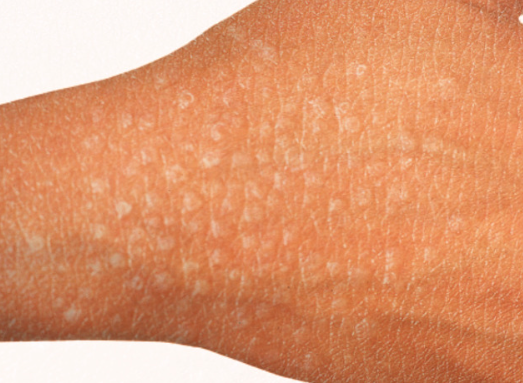Lichen nitidus is a benign, small-papular dermatosis of unknown etiology that occurs predominantly in children and adolescents. ICD-10 Code: L44.1
While most commonly affecting children and adolescents, this condition can sometimes occur in adults.
The etiology and pathogenesis of the disease remain unknown. Some authors consider lichen nitidus to be a distinct disease because of its clinical presentation and characteristic histologic features. Other authors consider it to be a variant of lichen planus, but the course of the disease and the nature of the histopathologic skin changes are completely different pathologies. Some have suggested that lichen nitidus may represent a peculiar lichenoid reaction associated with tuberculosis intoxication or sarcoidosis. However, the lack of convincing evidence linking patients with lichen nitidus to tuberculosis of the internal organs contradicts the hypothesis of a tuberculosis origin.
It is plausible to consider this dermatosis, similar to lichen planus, as a lichenoid reaction of the skin in specific cases, attributed to various endogenous and exogenous factors.In classic presentation of lichen nitidus, small (1-3 mm in diameter), round, and sometimes polygonal firm papules are present. They have a shiny, smooth, slightly convex or flat surface with a color resembling normal skin or a pale pink hue. Subjective discomfort is usually absent, although occasional pruritus may occur.
Rash elements may be grouped in circular patches or scattered, but they never coalesce. Rarely, minimal scaling with elements of hyperkeratosis may be seen on the surface of the lesions. Koebner's phenomenon may be positive during the active stages of the disease.
Most often the rash is localized on the skin of the penis, inner surfaces of forearms, elbow creases and popliteal fossae. Sometimes rashes appear on the lower abdomen or side of the torso. In rare cases, rash elements may manifest on the oral mucosa.
Remarkably, in majority of cases, the facial skin and scalp remain unaffected. However, a variant of the disease localized to the face has been described, known as actinic (sun-exposed) lichen nitidus.
A generalized rash is extremely rare. There are reports of Blaschko localization.
Atypical presentations include hemorrhagic and vesicular forms of the disease.
Involvement of the nail has been observed in some cases.
The course of the dermatosis is chronic, prolonged, with a favorable prognosis. Lichen nitidus tends to resolve spontaneously within a year.- Atopic Dermatitis
- Lichen Planus
- Micropapular Syphilis
- Lichen Spinulosus
- Keratosis pilaris
- Molluscum Contagiousum
- Traumatic anserine folliculosis
- Flat Warts
Treatment is generally not required for most cases of lichen nitidus as it is a self-healing condition.
For pruritus, glucocorticoids or calcineurin inhibitors may be used topically, or H1 blockers may be administered orally.
Successful oral administration of isotretinoin has been reported for the generalized form of the disease.
UVB therapy may be useful.
